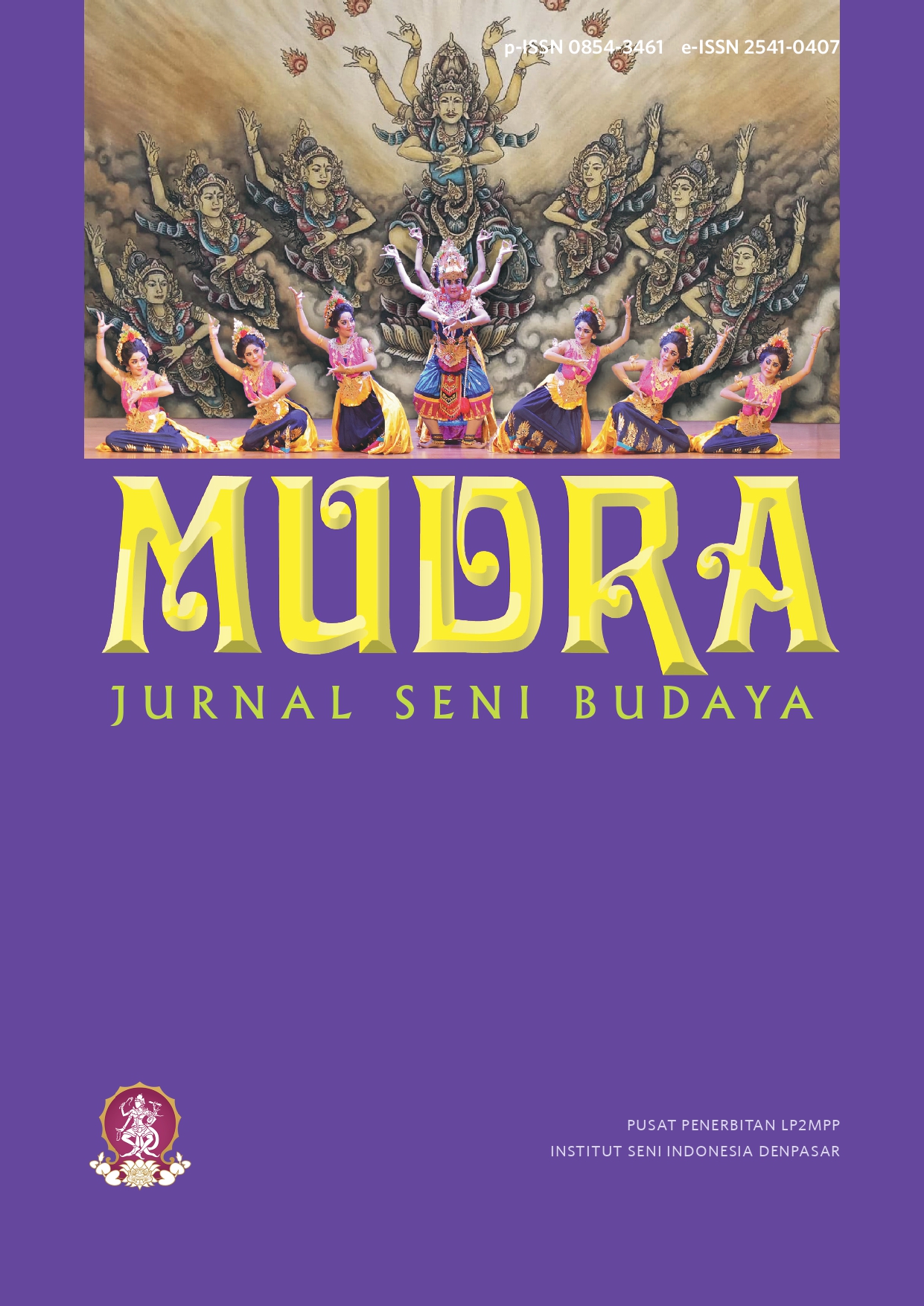Review of Shape and Color on Poleng Motifs in Bali
DOI:
https://doi.org/10.31091/mudra.v38i1.1983Keywords:
Balinese Cultural Identity, Balinese Poleng Motif, Color, Form, Poleng MotifsAbstract
In the beginning, the poleng motif was a sacred motif by the Balinese people. The poleng motif has a meaning as a form of petition and protection to God Almighty in His form and manifestation as creator, preserver, and harmonizing to achieve a happy and prosperous life. Another meaning is as a form to neutralize and restore balance from dark forces to help achieve the perfection of life. In its application as a motif wrapped around sacred objects, the poleng motif has the meaning of a repellent to strengthen and as a place of worship of God in His manifestation as a guardian. In subsequent developments due to tourism with increasing local and foreign tourist visits, the poleng motif has functioned as a decoration. This shift certainly leads to a reinterpretation of the meaning of the poleng motif in Bali. This study aims to get a new meaning for the poleng motif in Bali. To get this new meaning, a qualitative methodology is used based on the theoretical basis of Panofsky's iconology which emphasizes the study of visual analysis. The study carried out resulted in new findings in the form of a new meaning for the poleng motif. Based on the analysis, it was found that there was a shift in meaning from sacred to profane with the new meaning of the poleng motif being cultural communication. The form of communication created is a self-image product that reflects Balinese cultural identity. Local cultural identity is used to introduce Balinese culture.
Downloads
References
Adnyana, IG, & Watra, IW (2017). Segehan Philosophy at the Bhuta Yadnya Ceremony at the Agung Kentelgumi Temple, Klungkung. Denpasar: Indonesian Hindu University.
Adnyana, IW, Remawa, AR, & Sari, NL (2018). Multinarrative Relief Yeh Pulu Basis for the Creation of Contemporary Painting. Mudra Journal of Cultural Arts, Vol. 33, no. 2, 249-255. https://doi.org/10.31091/mudra.v33i2.372
Arifin, F. (2016). Representation of Hindu Temple Symbols in Human Life: An Anthropological Linguistic Study. Humanities, Vol. 16, No. 2, 12-20.
Atmadja, NB, Atmadja, AT, & Maryati, T. (2017). Banten Island Bali: A Sociological Perspective on the Commodification of Religion. Denpasar: Larasan Library in collaboration with IBIKK BCCC Undiksha Singaraja.
Barthes, R. (2010). Dissecting the Myths of Mass Culture: Semiotics or Sociology of Signs, Symbols, and Representation. Yogyakarta: Jalasutra.
Darmaprawira, S. (2002). Color: Theory and Creativity in Its Use 2nd edition. Bandung: ITB Publisher.
Fitriona, N. (2016). Iconography and Painting Iconology Study by A. Arifin Malin Deman II. INVENTION: Journal of Art Creation and Studies, Vol. 1, No. 1, 13-25.
Hassan, RP (2015). Visual Analysis of Poleng Motifs on Dodotan Bima Wanda Lindu Panon Jogjakarta. ATRAT: Journal of Fine Arts, Vol. 3, No. 1 , 1-9.
Herlina, Y. (2021). Development and Creativity of Paradila Batik Ikat Weaving Design. In TIM, Anthology of Cultural Arts Studies of Various Perspectives (pp. 136-149). Surabaya: UNESA UNIVERSITY PRESS.
Jaya, IK, & Kusuma, IM (2020). The Existence of Symbols in Hindu Worship in Bali from the Perspective of Hindu Theology. Sphatika: Journal of Theology, Vol. 11, no. 2, 180-192.
Karja, IW (2020). Balinese Cosmology: Color Visualization of Pangider Bhuwana in Contemporary Painting. Denpasar: UNHI Press.
Mantra, IB (1990). Bali, Socio-Cultural Problems and Modernization. Denpasar: PT. Upada Literature.
Maulana, R. (1997). Hindu iconography. Jakarta: Faculty of Letters, University of Indonesia.
Nala, N. (2006). Balinese script in Usada. Surabaya: Paramita.
Panofsky, E. (1955). Meaning in The Visual Arts. New York: Doubleday & Company, Inc.
Piliang, YES, & Jaelani, J. (2018). Contemporary cultural theory: Exploration of Signs & Meaning. Yogyakarta: Library Cantrik.
Puspa, IA, Saitya, IB, & Siswadi, GA (2020). Canang Sari Aesthetic Theo. Purwadita: Journal of Religion and Culture, Vol. 4, No. 2, 157-170.
Rupawan, IK (2008). Saput Poleng in Hindu Religious Life in Bali. Denpasar: Bali Post Library.
Sandika, IK (2019). Tantra: Archipelago Ancient Science. Banten: Javanica.
Sari, NL, & Ari, IA (2013). Representation of Poleng Motifs in "Awani" Packaging Design (Semiotics Studies). Segara Widya, Vol. 1, No. 1 , 1-9.
Sarjani, NK, & Cahyadi, IW (2016). Local Cultural Identity in Baline Chocolate Packaging Design. Segara Widya, Vol. 4, No. 1 , 1-15.
Suda, IK (2010). The Ideology of Environmental Conservation Behind the Use of Saput Poleng on Big Trees in Bali. Sustainable Earth Journal, Vol. 10 No. 2, 333-340.
Sudarsana, IB (2010). Yadnya Upakara Competitive Association. Denpasar: Binanjaya.
Suhersono, H. (2005). Fauna Motif Embroidery Design. Jakarta: PT. Main Library Gramedia.
Sukiani, NK (2019). Function & Meaning of Banten Prayascita in Denpasar City. Kulturistik: Journal of Language and Culture, Vol. 3, No. 1, 84-98.
Swandi, IW, Wibawa, AP, & Mahaputra, IG (2019). Iconographic Study on Rangda Theme T-Shirt Painting by I Nyoman Ngurah Ardika Yasa. Mudra: Journal of Cultural Arts, Vol. 34, no. 2 , 213-222. https://doi.org/10.31091/mudra.v34i2.703
Titib, IM (2003). Theology & Symbols in Hinduism. Surabaya: Paramita.
Wardhani, AW, & Franzia, E. (2020). Depiction of Sekala and Niskala Beliefs in Balinese Society in the film "The Seen and Unseen". Journal of Visual Art and Design DKV Dimensions, Vol. 5, No. 1, 19-32.
Downloads
Published
How to Cite
Issue
Section
License
Copyright (c) 2023 Arya Pageh Wibawa, Imam Santosa, Setiawan Sabana, Achmad Haldani Destiarmand

This work is licensed under a Creative Commons Attribution-NonCommercial-ShareAlike 4.0 International License.
- Copyright on any open access article in a journal published by Mudra Jurnal Seni Budaya is retained by the author(s).
-
The Creative Commons Attribution License 4.0 formalizes these and other terms and conditions of publishing articles.









